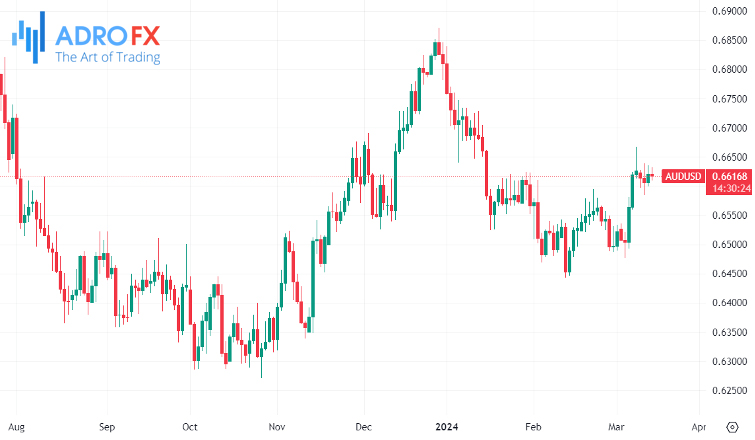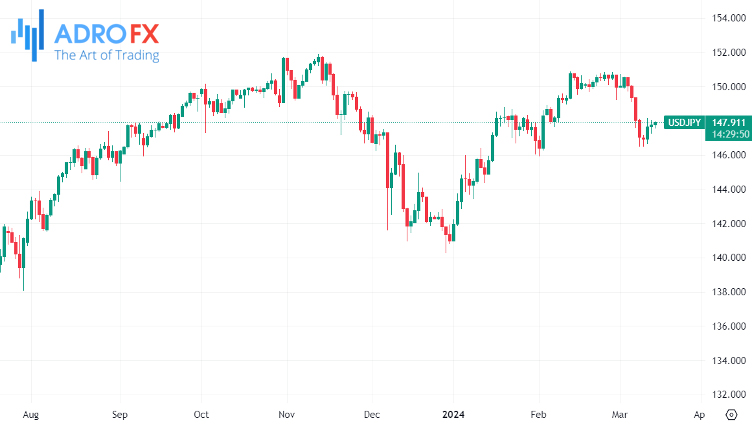Dow Inches Higher Despite Tech Slump As Gold Faces Selling Pressure | Daily Market Analysis

Key events:
- USA - Core Retail Sales (MoM) (Feb)
- USA - Initial Jobless Claims
- USA - PPI (MoM) (Feb)
- USA - Retail Sales (MoM) (Feb)
On Wednesday, the Dow managed to edge higher for a third consecutive day, bolstered by gains in energy stocks, although a decline in tech stocks tempered overall market gains. Investor focus remained on forthcoming economic data scheduled for Thursday, which could influence the Federal Reserve's outlook before its decision next week.
The Dow Jones Industrial Average edged up by 37 points, or 0.1%, while the S&P 500 dipped by 0.2% and the NASDAQ Composite retreated by 0.5%.

Tesla (NASDAQ: TSLA) shares experienced a 1.5% decline in early trading in New York after Wells Fargo downgraded the stock's rating to Underweight (equivalent to sell) from Equal Weight. Analysts expressed concerns about Tesla's growth prospects, referring to it as "a growth company with no growth."
Additionally, Wells Fargo slashed the price target by up to $75 to $125 per share, suggesting a potential downside risk of nearly 30% based on Tuesday's closing price of $177.54. Tesla shares have declined by as much as 28.5% year-to-date, contrasting with the S&P 500's gain of +8.5%.

The US House of Representatives passed a bill that could lead to the ban of TikTok in the United States unless its Chinese owner Bytedance sells the company within six months due to national security concerns. However, the bill, known as the Protecting Americans from Foreign Adversary Controlled Applications Act, faces uncertainty in the Senate due to disagreements among lawmakers.
A potential ban on TikTok in the US could benefit rival social media platforms such as Meta (NASDAQ: META)'s Instagram and Google (NASDAQ: GOOGL)'s YouTube, according to Seema Shah, Vice President at Sensor Towers, speaking to Bloomberg on Wednesday.
Gold price faced selling pressure during Thursday's Asian session, partially retracing its previous day's recovery from the weekly low. The US Dollar gained traction amid speculation that the Federal Reserve might postpone interest rate cuts, supported by robust US inflation data. Additionally, the recent bullish performance in global equity markets exerted downward pressure on the safe-haven gold.

However, expectations of the Fed initiating rate cuts in June are likely to limit the significant upside for the Greenback, offering some support to non-yielding assets like gold. Moreover, ongoing geopolitical tensions are expected to provide a floor for the XAU/USD pair's downside.
The Australian Dollar retreated during Thursday's trading session after giving up its earlier intraday gains. The AUD/USD pair had strengthened on expectations of the Fed cutting interest rates in June, while the Reserve Bank of Australia hinted at the possibility of raising rates further. RBA Governor Michelle Bullock attributed Australia's inflation primarily to domestic factors such as a strong labor market and rising wage inflation, projecting that inflation won't reach target levels until 2026.

The Australian financial sector's decline, reflected in the lower S&P/ASX 200 Index, contributed to downward pressure on the Australian Dollar. Losses in major financial institutions like Westpac Banking, Commonwealth Bank, ANZ Group, National Australia Bank, and Macquarie Group overshadowed gains in iron ore miners.
The Japanese Yen experienced its third consecutive decline against the US Dollar, hovering near the weekly low reached earlier in the week. The Bank of Japan's Governor Kazuo Ueda's cautious assessment of the economy dampened hopes for an early interest rate hike. The ongoing rally in global equities also undermined the safe-haven appeal of the JPY.

However, expectations of substantial pay hikes by Japan's leading companies, boosting consumer spending and demand-driven inflation, may prompt the BoJ to reconsider its ultra-loose monetary policy in the coming months. Additionally, persistent geopolitical tensions are likely to prevent significant losses for the safe-haven Japanese Yen.
Investors will closely scrutinize the producer price index data and retail sales data for February, scheduled for release on Thursday, for insights into inflation and consumer spending strength, respectively, ahead of the Fed's meeting on Mar.19-20. The Federal Reserve is widely expected to maintain interest rates unchanged during the upcoming meeting.









